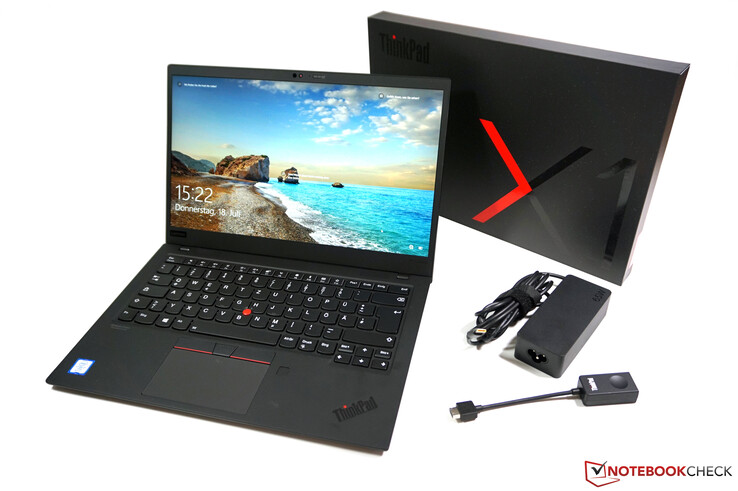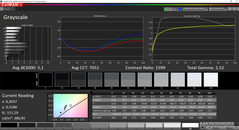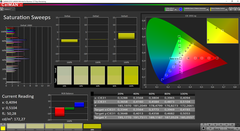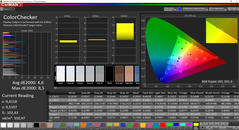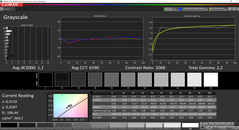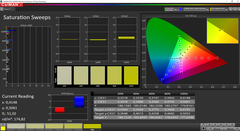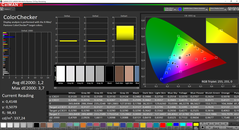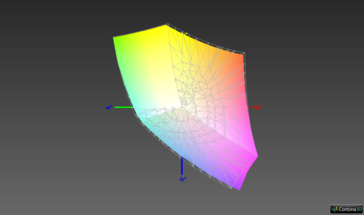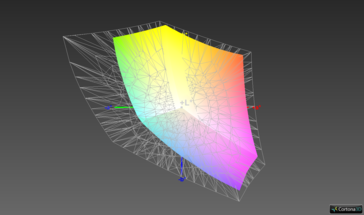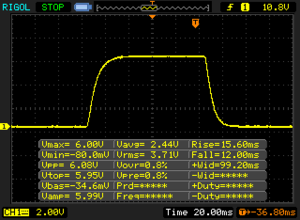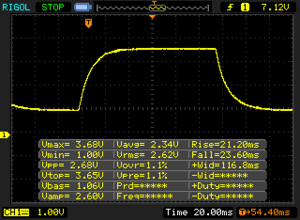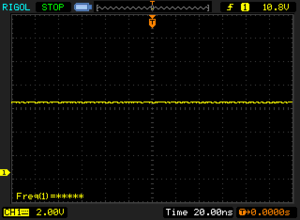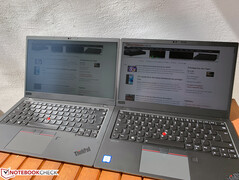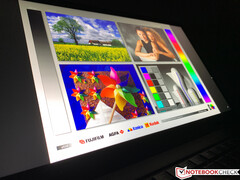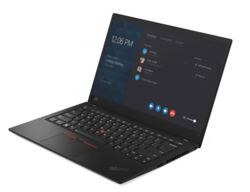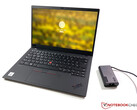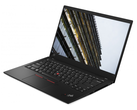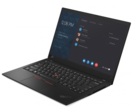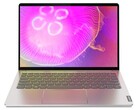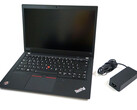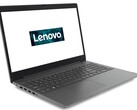Lenovo ThinkPad X1 Carbon 2019 with Full HD laptop review: Brighter and longer battery life

We already knew the matte WQHD panel of the ThinkPad X1 Carbon 2019 from the predecessor, but the cheaper entry-level panel with Full HD resolution and a brightness of 400 nits is likely to be the more exciting option for many users, even when it comes to battery life. Our review device is a Campus model called ThinkPad X1 Carbon 2019-20QES01L00 that costs 1,499 Euros (~$1,672). In this update we'll focus on the display and the battery life. For further information about the device, please refer to our reviews of the ThinkPad X1 Carbon from 2019 or 2018 and its different display versions:
- Lenovo ThinkPad X1 Carbon 2019 (i7, WQHD matte)
- Lenovo ThinkPad X1 Carbon 2018 (i7, WQHD HDR glossy)
- Lenovo ThinkPad X1 Carbon 2018 (i5, FHD touch matte)
Note: Actually, WWAN is not retrofittable with the ThinkPad X1 Carbon 2019. If you don't order it directly during the ordering process, the SIM slot on the back is missing and no antennas are laid. However, the Campus model is an exception, because WWAN is set up here. The SIM slot is available, and the antennas are also integrated. In theory, you could simply install an LTE module, but you can't buy a corresponding module yet. This mess is anything but customer-friendly, and in our opinion, all versions should be WWAN-ready.
The following photos of the case come from the X1 Carbon 2019 with the matte WQHD display.
Display
The Full HD panel in our review device is the standard model for the ThinkPad X1 Carbon. As we've already discovered, Lenovo uses panels from a total of four different suppliers; in this case it comes from LG Philips. In terms of metrics, the LG Philips panel sits behind the Innolux, but it's ahead of the two other versions. Unfortunately, there's no way to know in advance which panel was used. A detailed overview with the measurements of all four options can be found in our special article.
With the exception of the resolution, the Full HD panel doesn't have any disadvantages compared to the WQHD display. Quite the contrary, it's even ahead in regard to the brightness and contrast ratio. The subjective impression is very good, and the 1080p resolution on the 14-inch panel is likely to be sufficient for many purposes too. There's only minimal screen bleeding in both top corners, but this is not bothersome in practice. PWM is not used.
| |||||||||||||||||||||||||
Brightness Distribution: 94 %
Center on Battery: 380 cd/m²
Contrast: 1588:1 (Black: 0.24 cd/m²)
ΔE ColorChecker Calman: 4.6 | ∀{0.5-29.43 Ø4.78}
calibrated: 1.2
ΔE Greyscale Calman: 5.1 | ∀{0.09-98 Ø5}
95.7% sRGB (Argyll 1.6.3 3D)
60.7% AdobeRGB 1998 (Argyll 1.6.3 3D)
65.7% AdobeRGB 1998 (Argyll 3D)
95.8% sRGB (Argyll 3D)
64.5% Display P3 (Argyll 3D)
Gamma: 2.52
CCT: 7052 K
| Lenovo ThinkPad X1 Carbon 2019-20QES01L00 LP140WF9_SPF1, IPS, 1920x1080, 14" | Lenovo ThinkPad X1 Carbon 2019-20QE000VGE LP140QH2-SPD1, IPS, 2560x1440, 14" | Lenovo ThinkPad X1 Carbon G6-20KG0025UK Lenovo LEN40A9 / AUO B140HAK02.3, IPS, 1920x1080, 14" | Lenovo ThinkPad X1 Carbon 2018-20KGS03900 B140QAN02.0, IPS, 2560x1440, 14" | Average of class Office | |
|---|---|---|---|---|---|
| Screen | -18% | 8% | 24% | -19% | |
| Brightness middle (cd/m²) | 381 | 338 -11% | 298 -22% | 578 52% | 413 ? 8% |
| Brightness (cd/m²) | 375 | 315 -16% | 287 -23% | 533 42% | |
| Brightness Distribution (%) | 94 | 88 -6% | 91 -3% | 84 -11% | |
| Black Level * (cd/m²) | 0.24 | 0.43 -79% | 0.2 17% | 0.38 -58% | 0.2432 ? -1% |
| Contrast (:1) | 1588 | 786 -51% | 1490 -6% | 1521 -4% | |
| Colorchecker dE 2000 * | 4.6 | 4 13% | 2.19 52% | 1.9 59% | 4.22 ? 8% |
| Colorchecker dE 2000 max. * | 8.5 | 7.9 7% | 4.39 48% | 3.8 55% | 11.1 ? -31% |
| Colorchecker dE 2000 calibrated * | 1.2 | 1.7 -42% | 1.67 -39% | 0.8 33% | 2.6 ? -117% |
| Greyscale dE 2000 * | 5.1 | 6.2 -22% | 1.97 61% | 3 41% | 4.1 ? 20% |
| Gamma | 2.52 87% | 2.13 103% | 2.43 91% | 2.14 103% | 2.22 99% ? |
| CCT | 7052 92% | 6787 96% | 6571 99% | 6377 102% | 6722 97% ? |
| Color Space (Percent of AdobeRGB 1998) (%) | 60.7 | 68.1 12% | 62 2% | 88.8 46% | |
| Color Space (Percent of sRGB) (%) | 95.7 | 97.8 2% | 95 -1% | 100 4% |
* ... smaller is better
On factory settings, the average deviations in grayscales and colors compared to the sRGB reference color-space are still outside the target (smaller <3). In addition, the color temperature is slightly too cool. However, the values are still perfectly fine, especially for an office laptop. But if you want to tap the display's full potential, you can't avoid calibration. As always, our calibrated profile is available to download freely (link in the display box above). After the calibration, all values are within the target, together with an almost complete coverage of sRGB; image-editing is also possible.
Display Response Times
| ↔ Response Time Black to White | ||
|---|---|---|
| 27.6 ms ... rise ↗ and fall ↘ combined | ↗ 15.6 ms rise | |
| ↘ 12 ms fall | ||
| The screen shows relatively slow response rates in our tests and may be too slow for gamers. In comparison, all tested devices range from 0.1 (minimum) to 240 (maximum) ms. » 69 % of all devices are better. This means that the measured response time is worse than the average of all tested devices (20.2 ms). | ||
| ↔ Response Time 50% Grey to 80% Grey | ||
| 44.8 ms ... rise ↗ and fall ↘ combined | ↗ 21.2 ms rise | |
| ↘ 23.6 ms fall | ||
| The screen shows slow response rates in our tests and will be unsatisfactory for gamers. In comparison, all tested devices range from 0.165 (minimum) to 636 (maximum) ms. » 75 % of all devices are better. This means that the measured response time is worse than the average of all tested devices (31.6 ms). | ||
Screen Flickering / PWM (Pulse-Width Modulation)
| Screen flickering / PWM not detected | |||
In comparison: 53 % of all tested devices do not use PWM to dim the display. If PWM was detected, an average of 8111 (minimum: 5 - maximum: 343500) Hz was measured. | |||
Battery life
In our Wi-Fi test, the ThinkPad X1 Carbon 2019 with the Full HD panel lasts around an hour longer than the WQHD model, and with video reproduction, even almost 90 minutes longer. This means that the 2019 X1 Carbon is also a little closer to its predecessor with the larger battery, which still has the edge in the Wi-Fi test.
| Lenovo ThinkPad X1 Carbon 2019-20QES01L00 i7-8565U, 51 Wh, 1920x1080 | Lenovo ThinkPad X1 Carbon 2019-20QE000VGE i7-8665U, 51 Wh, 2560x1440 | Lenovo ThinkPad X1 Carbon 2018-20KGS03900 i5-8550U, 57 Wh, 2560x1440 | Lenovo ThinkPad X1 Carbon G6-20KG0025UK i5-8350U, 57 Wh, 1920x1080 | |
|---|---|---|---|---|
| Battery runtime | -14% | -13% | 4% | |
| H.264 (h) | 11.5 | 9.8 -15% | 9.4 -18% | 11 -4% |
| WiFi v1.3 (h) | 9.4 | 8.2 -13% | 8.7 -7% | 10.4 11% |
Pros
Cons
Verdict
As with some other current ThinkPads, this version of the low-power 1080p display is also able to convince. Although there's the risk of getting one of the two panels with lower response times, it's a big step forward in comparison to last year's standard display. For this reason, one should slightly question the right to exist for the matte WQHD panel. While it offers a somewhat higher resolution, it falls a bit behind in terms of contrast and brightness in return.
Otherwise, the pros and cons that we already described in our thorough review of the ThinkPad X1 Carbon 2019 WQHD naturally apply here too. The only difference is the WWAN module, which is theoretically retrofittable with the Campus model.
Brighter, better contrast ratio and lower energy consumption: The new standard 1080p display of the ThinkPad X1 Carbon is likely to be the best choice for most users. The price premium required for the matte WQHD panel is actually only worth it if you absolutely need the slightly higher resolution. However, this more expensive display doesn't offer any other advantages.
Lenovo ThinkPad X1 Carbon 2019-20QES01L00
- 09/13/2019 v7 (old)
Andreas Osthoff




